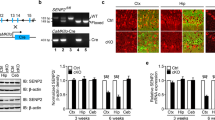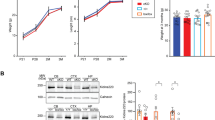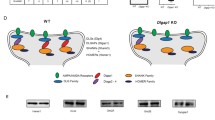Abstract
NUMB is a key regulator of neurogenesis and neuronal differentiation that can be ubiquitinated and targeted for proteasomal degradation by ligand of numb protein-X (LNX) family E3 ubiquitin ligases. However, our understanding of LNX protein function in vivo is very limited. To examine the role of LNX proteins in regulating NUMB function in vivo, we generated mice lacking both LNX1 and LNX2 expression in the brain. Surprisingly, these mice are healthy, exhibit unaltered levels of NUMB protein and do not display any neuroanatomical defects indicative of aberrant NUMB function. Behavioural analysis of LNX1/LNX2 double knockout mice revealed decreased anxiety-related behaviour, as assessed in the open field and elevated plus maze paradigms. By contrast, no major defects in learning, motor or sensory function were observed. Given the apparent absence of major NUMB dysfunction in LNX null animals, we performed a proteomic analysis to identify neuronal LNX-interacting proteins other than NUMB that might contribute to the anxiolytic phenotype observed. We identified and/or confirmed interactions of LNX1 and LNX2 with proteins known to have presynaptic and neuronal signalling functions, including the presynaptic active zone constituents ERC1, ERC2 and LIPRIN-αs (PPFIA1, PPFIA3), as well as the F-BAR domain proteins FCHSD2 (nervous wreck homologue) and SRGAP2. These and other novel LNX-interacting proteins identified are promising candidates to mediate LNX functions in the central nervous system, including their role in modulating anxiety-related behaviour.









Similar content being viewed by others
Abbreviations
- PDZ:
-
PSD-95
- DlgA:
-
ZO-1
- RING:
-
Really Interesting New Gene
- LNX:
-
Ligand of numb protein X
- CNS:
-
Central nervous system
- ERC:
-
ELKS/Rab6-interacting/CAST
- SVZ:
-
Subventricular zone
- PBK:
-
PDZ-binding kinase
- DKO:
-
Lnx1exon3−/−;Lnx2 −/− double knockout
- DHET:
-
Lnx1 exon3+/−;Lnx2 +/− double heterozygous knockout
- GFP:
-
Green fluorescent protein
- GST:
-
Glutathione S-transferase
- PCR:
-
Polymerase chain reaction
- PTB:
-
Phosphotyrosine-binding domain
References
Dho SE, Jacob S, Wolting CD, French MB, Rohrschneider LR, McGlade CJ (1998) The mammalian numb phosphotyrosine-binding domain. Characterization of binding specificity and identification of a novel PDZ domain-containing numb binding protein, LNX. J Biol Chem 273:9179–9187
Rice DS, Northcutt GM, Kurschner C (2001) The Lnx family proteins function as molecular scaffolds for Numb family proteins. Mol Cell Neurosci 18:525–540
Nie J, Li SS, McGlade CJ (2004) A novel PTB-PDZ domain interaction mediates isoform-specific ubiquitylation of mammalian Numb. J Biol Chem 279:20807–20815
Nie J, McGill MA, Dermer M, Dho SE, Wolting CD, McGlade CJ (2002) LNX functions as a RING type E3 ubiquitin ligase that targets the cell fate determinant Numb for ubiquitin-dependent degradation. EMBO J 21:93–102
Nayak D, Sivaraman J (2015) Structural basis for the indispensable role of a unique zinc finger motif in LNX2 ubiquitination. Oncotarget 6:34342–34357
Camps J et al. (2013) Genetic amplification of the NOTCH modulator LNX2 upregulates the WNT/beta-catenin pathway in colorectal cancer. Cancer Res
Gulino A, Di Marcotullio L, Screpanti I (2010) The multiple functions of Numb. Exp Cell Res 316:900–906
Weiss A, Baumgartner M, Radziwill G, Dennler J, Moelling K (2007) C-Src is a PDZ interaction partner and substrate of the E3 ubiquitin ligase ligand-of-Numb protein X1. FEBS Lett 581:5131–5136
Kuo CT et al (2006) Postnatal deletion of Numb/Numblike reveals repair and remodeling capacity in the subventricular neurogenic niche. Cell 127:1253–1264
Wang H, Kane AW, Lee C, Ahn S (2014) Gli3 repressor controls cell fates and cell adhesion for proper establishment of neurogenic niche. Cell Rep 8:1093–1104
Lenihan JA, Saha O, Mansfield LM, Young PW (2014) Tight, cell type-specific control of LNX expression in the nervous system, at the level of transcription, translation and protein stability. Gene 552:39–50
Flynn M, Saha O, Young P (2011) Molecular evolution of the LNX gene family. BMC Evol Biol 11:235
Wolting CD, Griffiths EK, Sarao R, Prevost BC, Wybenga-Groot LE, McGlade CJ (2011) Biochemical and computational analysis of LNX1 interacting proteins. PLoS One 6:e26248
Guo Z et al (2012) Proteomics strategy to identify substrates of LNX, a PDZ domain-containing E3 ubiquitin ligase. J Proteome Res 11:4847–4862
D’Agostino M, Tornillo G, Caporaso MG, Barone MV, Ghigo E, Bonatti S, Mottola G (2011) Ligand of Numb proteins LNX1p80 and LNX2 interact with the human glycoprotein CD8alpha and promote its ubiquitylation and endocytosis. J Cell Sci 124:3545–3556
Takahashi S, Iwamoto N, Sasaki H, Ohashi M, Oda Y, Tsukita S, Furuse M (2009) The E3 ubiquitin ligase LNX1p80 promotes the removal of claudins from tight junctions in MDCK cells. J Cell Sci 122:985–994
Young P, Nie J, Wang X, McGlade CJ, Rich MM, Feng G (2005) LNX1 is a perisynaptic Schwann cell specific E3 ubiquitin ligase that interacts with ErbB2. Mol Cell Neurosci 30:238–248
Heyer MP, Pani AK, Smeyne RJ, Kenny PJ, Feng G (2012) Normal midbrain dopaminergic neuron development and function in miR-133b mutant mice. J Neurosci 32:10887–10894
Heimer-McGinn V, Young P (2011) Efficient inducible Pan-neuronal cre-mediated recombination in SLICK-H transgenic mice. Genesis 49:942–949
Schneider CA, Rasband WS, Eliceiri KW (2012) NIH image to ImageJ: 25 years of image analysis. Nat Methods 9:671–675
Crawley JN (2008) Behavioral phenotyping strategies for mutant mice. Neuron 57:809–818
Irwin S (1968) Comprehensive observational assessment: Ia. A systematic, quantitative procedure for assessing the behavioral and physiologic state of the mouse. Psychopharmacologia 13:222–257
Rogers DC, Fisher EM, Brown SD, Peters J, Hunter AJ, Martin JE (1997) Behavioral and functional analysis of mouse phenotype: SHIRPA, a proposed protocol for comprehensive phenotype assessment. Mamm Genome 8:711–713
Cryan JF, Holmes A (2005) The ascent of mouse: advances in modelling human depression and anxiety. Nat Rev Drug Discov 4:775–790
Hughes RN (2004) The value of spontaneous alternation behavior (SAB) as a test of retention in pharmacological investigations of memory. Neurosci Biobehav Rev 28:497–505
Murphy AC, Lindsay AJ, McCaffrey MW, Djinovic-Carugo K, Young PW (2016) Congenital macrothrombocytopenia-linked mutations in the actin-binding domain of alpha-actinin-1 enhance F-actin association. FEBS Lett 590:685–695
Foley KS, Young PW (2013) An analysis of splicing, actin-binding properties, heterodimerization and molecular interactions of the non-muscle alpha-actinins. Biochem J 452:477–488
Saha O (2013) Investigation of the function of the LNX family of E3 ubiquitin ligases in the nervous system. PhD Thesis, University College Cork. https://cora.ucc.ie/handle/10468/1195
Petersen PH, Zou K, Hwang JK, Jan YN, Zhong W (2002) Progenitor cell maintenance requires numb and numblike during mouse neurogenesis. Nature 419:929–934
Zhong W, Feder JN, Jiang MM, Jan LY, Jan YN (1996) Asymmetric localization of a mammalian numb homolog during mouse cortical neurogenesis. Neuron 17:43–53
Klein AL, Zilian O, Suter U, Taylor V (2004) Murine numb regulates granule cell maturation in the cerebellum. Dev Biol 266:161–177
Shen Q, Zhong W, Jan YN, Temple S (2002) Asymmetric Numb distribution is critical for asymmetric cell division of mouse cerebral cortical stem cells and neuroblasts. Development 129:4843–4853
Zilian O, Saner C, Hagedorn L, Lee HY, Sauberli E, Suter U, Sommer L, Aguet M (2001) Multiple roles of mouse Numb in tuning developmental cell fates. Curr Biol 11:494–501
Zhong W, Jiang MM, Schonemann MD, Meneses JJ, Pedersen RA, Jan LY, Jan YN (2000) Mouse numb is an essential gene involved in cortical neurogenesis. Proc Natl Acad Sci U S A 97:6844–6849
Li HS et al (2003) Inactivation of Numb and Numblike in embryonic dorsal forebrain impairs neurogenesis and disrupts cortical morphogenesis. Neuron 40:1105–1118
Petersen PH, Zou K, Krauss S, Zhong W (2004) Continuing role for mouse Numb and Numbl in maintaining progenitor cells during cortical neurogenesis. Nat Neurosci 7:803–811
Rasin MR et al (2007) Numb and Numbl are required for maintenance of cadherin-based adhesion and polarity of neural progenitors. Nat Neurosci 10:819–827
Butler K, Martinez LA, Tejada-Simon MV (2013) Impaired cognitive function and reduced anxiety-related behavior in a promyelocytic leukemia (PML) tumor suppressor protein-deficient mouse. Genes Brain Behav 12:189–202
Semenova S, Contet C, Roberts AJ, Markou A (2012) Mice lacking the beta4 subunit of the nicotinic acetylcholine receptor show memory deficits, altered anxiety- and depression-like behavior, and diminished nicotine-induced analgesia. Nicotine Tob Res 14:1346–1355
Zhou L et al (2015) Numb deficiency in cerebellar Purkinje cells impairs synaptic expression of metabotropic glutamate receptor and motor coordination. Proc Natl Acad Sci U S A 112:15474–15479
Arroyo JD, Lee GM, Hahn WC (2008) Liprin alpha1 interacts with PP2A B56gamma. Cell Cycle 7:525–532
Liu YC et al (2014) The PPFIA1-PP2A protein complex promotes trafficking of Kif7 to the ciliary tip and Hedgehog signaling. Sci Signal 7:ra117
Higa S, Tokoro T, Inoue E, Kitajima I, Ohtsuka T (2007) The active zone protein CAST directly associates with Ligand-of-Numb protein X. Biochem Biophys Res Commun 354:686–692
Sudhof TC (2012) The presynaptic active zone. Neuron 75:11–25
Ko J, Na M, Kim S, Lee JR, Kim E (2003) Interaction of the ERC family of RIM-binding proteins with the liprin-alpha family of multidomain proteins. J Biol Chem 278:42377–42385
Nachat R, Cipolat S, Sevilla LM, Chhatriwala M, Groot KR, Watt FM (2009) KazrinE is a desmosome-associated liprin that colocalises with acetylated microtubules. J Cell Sci 122:4035–4041
Guerrier S et al (2009) The F-BAR domain of srGAP2 induces membrane protrusions required for neuronal migration and morphogenesis. Cell 138:990–1004
Charrier C et al (2012) Inhibition of SRGAP2 function by its human-specific paralogs induces neoteny during spine maturation. Cell 149:923–935
Dennis MY et al (2012) Evolution of human-specific neural SRGAP2 genes by incomplete segmental duplication. Cell 149:912–922
Ma Y, Mi YJ, Dai YK, Fu HL, Cui DX, Jin WL (2013) The inverse F-BAR domain protein srGAP2 acts through srGAP3 to modulate neuronal differentiation and neurite outgrowth of mouse neuroblastoma cells. PLoS One 8:e57865
Coyle IP, Koh YH, Lee WC, Slind J, Fergestad T, Littleton JT, Ganetzky B (2004) Nervous wreck, an SH3 adaptor protein that interacts with Wsp, regulates synaptic growth in Drosophila. Neuron 41:521–534
Ro H, Dawid IB (2009) Organizer restriction through modulation of Bozozok stability by the E3 ubiquitin ligase Lnx-like. Nat Cell Biol 11:1121–1127
Ro H, Dawid IB (2010) Lnx-2b restricts gsc expression to the dorsal mesoderm by limiting nodal and Bozozok activity. Biochem Biophys Res Commun 402:626–630
Ro H, Dawid IB (2011) Modulation of Tcf3 repressor complex composition regulates cdx4 expression in zebrafish. EMBO J 30:2894–2907
Acknowledgements
We are extremely grateful to Pat Fitzgerald and James O’Leary for their generous assistance and advice regarding behavioural experiments. We thank Mary McCaffrey (University College Cork) for access to her Science Foundation Ireland-funded confocal microscope and Jane McGlade (University of Toronto) for providing the rabbit anti-LNX1/2-RING/NPAY antibody. This work was supported by a Research Frontiers Programme grant from Science Foundation Ireland (08/RFP/NSC1382) and an Irish Research Council EMBARK Postgraduate Research Scholarship to Joan Lenihan. We thank Tom Moore for access to the EVOS FL Cell Imaging System.
Author information
Authors and Affiliations
Corresponding author
Ethics declarations
All animal experiments were approved by the Animal Experimentation Ethics Committee of University College Cork (No: 2013/028) and were conducted under licence (No: AE19130/P013) issued by the Health Products Regulatory Authority of Ireland, in accordance with the European Union Directive 2010/63/EU for animals used for scientific purposes.
Conflict of Interest
The authors declare that they have no conflict of interest.
Electronic supplementary material
ESM 1
(PDF 155 kb)
Rights and permissions
About this article
Cite this article
Lenihan, J.A., Saha, O., Heimer-McGinn, V. et al. Decreased Anxiety-Related Behaviour but Apparently Unperturbed NUMB Function in Ligand of NUMB Protein-X (LNX) 1/2 Double Knockout Mice. Mol Neurobiol 54, 8090–8109 (2017). https://doi.org/10.1007/s12035-016-0261-0
Received:
Accepted:
Published:
Issue Date:
DOI: https://doi.org/10.1007/s12035-016-0261-0




